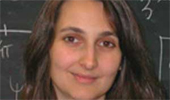
Dr.Alexander Nepomnyashchy
The Mathematics Department and Condensed Matter & Surface Sciences colloquium series present Dr. Alexander Nepomnyashchy discussing “Anomalous Dispersion in Laminar Flows” on Thursday, Jan. 25, at 4:10 p.m. in Walter 245.
Nepomnyashchy is with Technion-Israel Institute of Technology & Northwestern University.
Abstract: Dispersion of particles in chaotic, turbulent or random flows has been studied for a long time. It is known that the action of advection on large spatial and temporal scales typically can be described as an (anisotropic) normal diffusion process. In random but strongly correlated velocity fields, an anomalous diffusion is possible. Anomalous diffusion is possible also in spatially regular velocity fields in the presence of Lagrangian chaos.
It is less known that an anomalous transport can take place in steady two-dimensional flows, in the absence of any kind of chaos. In the present talk, we discuss two examples of such behavior.
The first example is the deterministic advection in spatially periodic, steady two-dimensional velocity fields, which include stagnation points or solid obstacles, so that the passage time is infinite along some streamlines. The large-time asymptotics of the dispersion law is analyzed using the special flow construction (a flow build over the mapping).
Depending on the type of the passage time singularity, the asymptotic dispersion law can correspond to either subdiffusion or superdiffusion.
The analytical predictions match the results of numerical simulations.
The second example is the diffusion-advection problem in spatially periodic, steady two-dimensional flows that contain closed cells, possibly separated by jets. The anomalous dispersion is predicted and found numerically on an intermediate time interval. On the large time case, a normal diffusion (enhanced by the flow) takes place. The dispersion displays peculiar aging properties.



















Comments